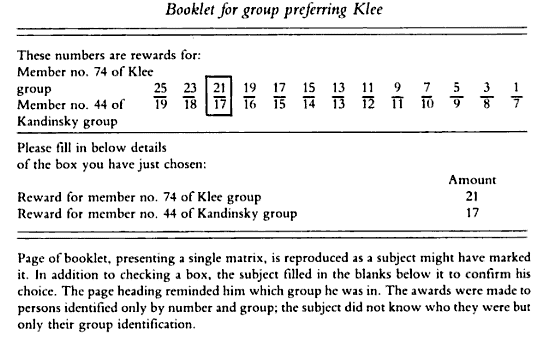Henri Tajfel
discrimination between social groups study
In this study into prejudice and discrimination between social groups, Henri Tajfel, Professor of Social Psychology at the University of Bristol,
England, and his colleagues invited the participation of forty-eight schoolboys all aged around fifteen to sixteen years.
The boys were randomly allocated to two either a "Klee group" or to a "Kandinsky group" after they had been involved in an exercise
where they were successively shown a series of slides of six pairs of unlabeled and unsigned abstract paintings they were told were by Paul Klee
and Wassily Kandinsky and were asked to express their preferences for one or the other as the slides were displayed.
Henri Tajfel and his colleagues were interested in investigating the minimal conditions under which discrimination between social groups
could be brought about. To this end, after they had expressed their preferences for one or other of the paintings, the boys were told,
(on a purely random basis), that they were in a "Klee" group or in a "Kandinsky" group.
In order to investigate any possible onset of discriminatory behaviours Henri Tajfel and his colleagues then asked the boys
to award points, worth a tenth-of-a-penny each, to other boys involved in the study as "reward for participation in the study".
The overall points awarded had the potential to leave quite a few pennies in each boys pocket as recompense for their
co-operation.
In order to attempt to investigate the onset of discrimination between social groups, under these minimal conditions where schoolboys had just been
"told" they were in a "Klee" group or in a "Kandinsky" group Henri Tajfel and his colleagues set up a scenario where boys were asked to
simultaneously allocate points
to two other numbered rather than named members of the Kandinsky group or members of the Klee group. Such allocation was anonymous, boys were asked
to work separately in this allocation in individual cubicles.

In this experiment matrices were employed which were designed to allow the experimenters
to investigate
any strategy that might be adopted by the boys when allocating points. These matrices were set up such that the
boys could potentially choose to allocate for maximum joint profit (MJP), or for maximum
profit for the in-group (MIP), or for maximum difference (MD) between the
points allocated for one group compared to the other.
- Maximum Joint Profit
- where boys could give the largest reward to members of both groups.
- Maximum In-group Profit
- where the boys could choose the largest reward for the member of their own group regardless of the reward to the boy from the other group.
- Maximum Difference
- where boys could choose the largest possible difference in reward between members of the different groups (in favour of the in-group).
![[]](local/henri_tajfel.gif)
The matrices consisted of 13 boxes, and were designed to
facilitate the use of any one of the three strategies, mentioned
above. In the centre of the matrices was a box with either 13 or
17 points in both the top and bottom rows, allowing for an equal
allocation. Towards the ends of the matrices a choice could be
made that would help to maintain maximum joint profit, maximum
ingroup profit or the maximum difference in amounts allocated
between the two groups.
The results demonstrated that when the boys had the choice
between maximising the profit for all and maximising the profit
for their own group, they chose the latter. Even more
interestingly though, the boys were found to be more concerned
with creating as large a difference as possible between the
amounts allocated to each group (in favour of their own group),
then in gaining a greater amount for everybody, across the two
groups. Tajfel points out that this last finding is evidence of blatant
discrimination associable with the categorisation of the boys into apparently meaningless groups.
The boys knew each other to be from the same year in a local school but, even so, they discriminated between social groups created
by someone telling them individually that they were in a "Klee" group or in a "Kandinsky" group.
|
|
![[social identity theory, henri tajfel]](../../local/enlightenment.gif)
![[social identity theory, henri tajfel]](../../local/enlightenment.gif)